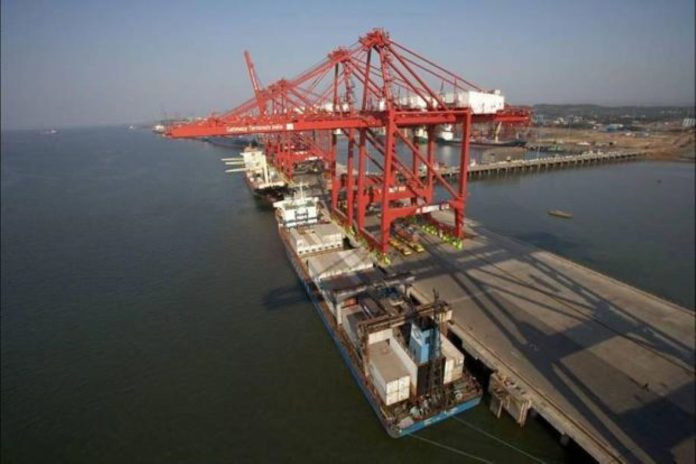As it moves up the ranks of the world’s biggest economies, India is scrambling to make huge ports, including three transhipment hubs to increase its share in global EXIM (export-import) trade.
Additionally, existing ports are upgrading their infrastructure to efficiently handle larger vessels and address growing trade volume needs.
Port modernisation relies heavily on equipment such as rail-mounted quay cranes, responsible for loading and unloading containers, and rail-mounted gantry cranes that stack containers in the port yard.
However, a predominant trend in these projects has been the procurement of cranes from Chinese suppliers, with Shanghai-based company, Zhenhua Port Machinery Company (ZPMC) being the primary source.
For example, Adani-built Vizhinjam International Port in Kerala, which is poised to become India’s first international deepwater transhipment port, has placed an order for eight rail-mounted quay cranes and 24 rail-mounted gantry cranes to ZPMC.
Likewise, the Mundra port in Gujarat, managed by Adani, also relies on ZPMC for its crane requirements. Notably, in October 2023, the Chinese vessel ‘Zhen Hua 15’ discharged two ship-to-shore cranes at Mundra en route to Vizhinjam.
The dominance of Chinese-built cranes is evident, as more than 250 Chinese-made cranes were actively in operation at diverse ports across India by the end of 2020, including Jawaharlal Nehru Port Trust (JNPT), the country’s largest container port.
There are compelling reasons why operators prefer Chinese cranes, the predominant supplier of cargo handling equipment.
According to an executive overseeing terminal operations at a private terminal, Chinese port equipment stands out for its competitive pricing and shorter lead times. In contrast, European gear is costlier and have longer lead time.
In fact, the near monopoly of ZPMC is attributed to its state-owned status, allowing it to offer competitive prices without profit pressure.
Policy Restrictions
Adding a compelling twist to the situation, the centre in 2020 hit back at Beijing with more economic restrictions in the wake of the border dispute between the two countries.
A public procurement order issued on 23 July prohibits equipment manufacturers from countries sharing a land border with India (without explicitly naming China) from participating in publicly funded infrastructure projects.
Consequently, the new rules effectively exclude Chinese firms from supplying cranes.
Notably, the first phase of the Chabahar port in Iran experienced delays when New Delhi canceled a $29.8 million contract with ZPMC for the purchase of four rail-mounted quay cranes.
India Ports Global Ltd (IPGL), the entity formed to develop and run the India-funded Chabahar port, has since canceled two additional tenders for purchasing four quay cranes, underscoring the challenge of replacing Chinese equipment.
To the surprise and amusement of many, the government’s order limiting equipment sourcing from China does not affect the majority of ongoing projects in India, as it does not apply to the private sector, including public-private partnership (PPP) projects for cargo terminals.
Beyond trade conflicts, Chinese equipment also poses “potential security vulnerabilities,” as there is a risk that the sensitive data gathered by these cranes could be exploited to disrupt a country’s trade operations entirely. Crucially, the software used in these automated cranes is also created by China.
According to a March 2023 report from the Wall Street Journal (WSJ), these cranes “contain sophisticated sensors that can register and track the provenance and destination of containers.”
The report had quoted a US counterintelligence official as saying that “the cranes could also provide remote access for someone looking to disrupt the flow of goods.”
The Alternative
Given the significant logistical challenges that may arise if ports discontinue the use of Chinese cranes, a pragmatic approach involves gradually developing indigenous capabilities for designing and manufacturing essential equipment crucial for our ports.
By fostering domestic expertise, we not only enhance self-reliance but also mitigate the risks associated with over-reliance on external suppliers.
Offering a glimmer of optimism, in January 2023, the Finnish company Konecranes forged a licensing agreement with Larsen & Toubro (L&T) to produce and distribute its port cranes in India.
Konecranes and L&T’s Minerals & Metals collaboration covers various cranes, including ship-to-shore, rail-mounted gantry, rubber-tired gantry, and shipyard cranes.
The first order under this agreement was from Cochin Shipyard for two shipyard cranes and is being manufactured at L&T’s Kanchipuram facility in Tamil Nadu, with delivery scheduled for November 2024.
However, to counter the global dominance of China, it is imperative to establish numerous such collaborations and agreements. India must cultivate its stakeholders in this endeavor, particularly as we embark on the construction of ports not only within India but also on a global scale.


